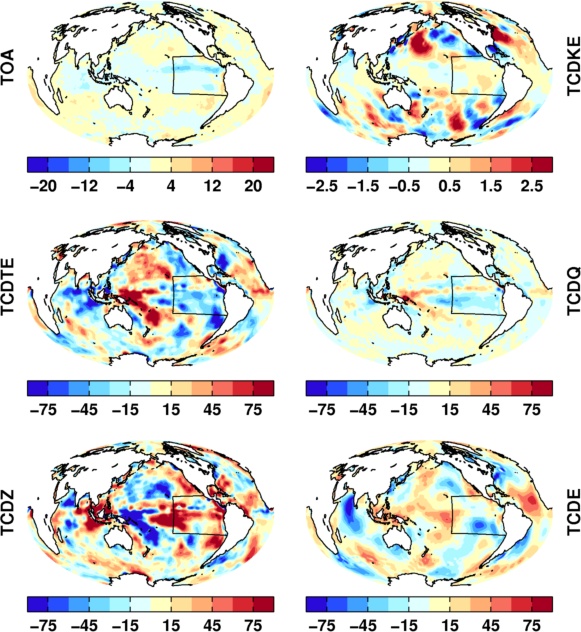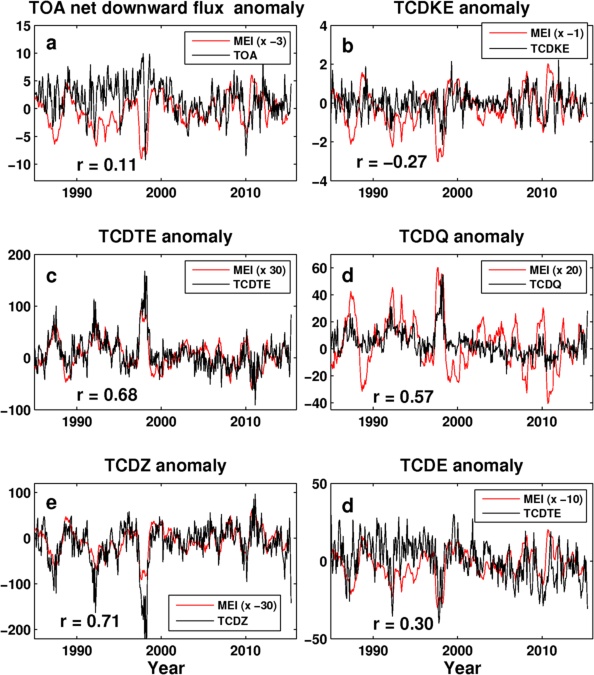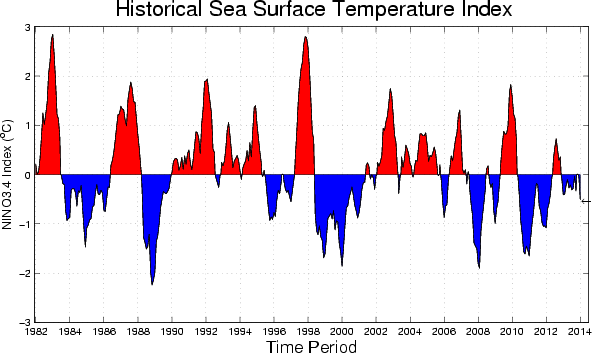Wednesday 16/12/2015
Energy changes over Eastern Central Pacific
1. Aims
To investigate the contribution of energy components to net downward surface fluxes over the eastern Pacific (20oN-20oS, 210oE to the west coast of Central America) area, the convergence of each component from the ERAI-Interim reanalysis is investigated.
- The spatial structures of the surface flux change over the oceans between the ERA-Interim output and the estimated data are similar.
- So the component contributions from ERA-Interim reanalysis will give some information.
2. Results

Fig. 1: Multiannual mean changes (2001-2008 minus 1986-2000) of (a) TOA net downward flux, and vertical integral of convergences of (b) kinetic energy (TCDKE), (c) thermal energy (TCDTE), (d) latent heat (TCDQ), (e) geopotential (TCDZ) and (f) total energy. The units are W/m2
- In the plot, it is the convergence ( = -divergence).
- As in our paper, the eastern Pacific area is marked (20oN-20oS, 210oE to the west coast of Central America).
- The fields having negative trends over the eastern Pacific area are: TOA flux, convergence of thermal energy (TCDTE) and convergence of moisture (TCDQ).
- The TOA flux contribution is small (note its magnitude).
- The TCDTE contribution is larger than that of TCDQ.

Fig. 2: The corresponding area mean anomaly time series relative to 2001-2005. (a) TOA net downward flux, vertical integral of convergences of (b) kinetic energy (TCDKE), (c) thermal energy (TCDTE), (d) latent heat (TCDQ), (e) geopotential (TCDZ) and (f) total energy. The units are W/m2
- The red line is MEI index, equivalent to the Nino index. Note: it is multiplied by different factors in different panel.
- The convergence fields are more or less affected by the ENSO signal.
- TCDTE, TCDQ and TCDZ are all strongly influenced by ENSO.
- TCDTE is the main contributor to the eastern Pacific net surface flux trend.
3. Conclusions
Over the eastern Pacific region (20oN-20oS, 210oE to the west coast of Central America)
- TCDTE is the main contributor to the eastern Pacific net surface flux trend.
- It happened that there are 3 profound ENSO events between 1986-2000 (as shown below), which enhances the convergences of the thermal and latent heat (water vapour content) energy fluxes due to higher surface temperature.
- It is also checked that the mass correction to the total energy divergence is not responsible for the negative trend.
- The energy tendency effect is also very small and can be neglected.
- This is a quick investigation, the detailed study may need the convergence change over each layer.

Copied from http://iri.columbia.edu/our-expertise/climate/forecasts/enso/2014-february-quick-look/


